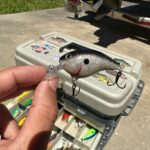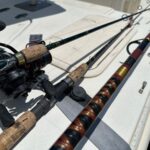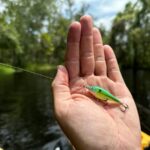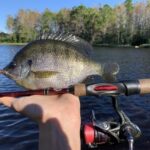Most bass anglers are accustomed to using their ‘confidence baits‘ when out on the water.
For many, this is a speed worm, a chatterbait, or another popular and trendy lure.
But in this article I am going to cover using plastic lizards for bass fishing, and why this may be the most under-utilized tactic…especially when big bass are on the bed.
This page contains affiliate links. As an Amazon Associate, I earn from qualifying purchases.
Table of Contents
What is Lizard Fishing for Bass?
Lizard fishing for bass consists of using a plastic lure that closely resembles a lizard or salamander. These plastic lures can be fished in a variety of different ways and can produce some impressive strikes when fished correctly.
Lizards are very versatile and can be fished with a variety of different rigs such as the Carolina rig, Texas rig, split shot rig, weightless, and even more.
Their ability to be used in a variety of different conditions and situations make them a favorite amongst bass anglers, especially during spawning season.
Are Lizards Good Bait for Bass?
Lizard fishing generally refers to using plastic lures that imitate lizards, not actual lizards themselves.
Plastic lizards give off a larger profile in the water than a traditional worm, and it’s theorized they resemble a salamander, eel, or even a snake!
This is why plastic lizards are a great option. Not only do they very closely resemble real lizards in size and shape, but also how they move through the water. Bass will eat lizards when given the opportunity, as they see them as a food source and as a threat to their nests during the spawn.
Why Do Bass Eat Lizards?
Bass love to eat things like shiners and minnows, but many are surprised to find out just how many small creatures largemouth bass actually eat.
Lizards (and more commonly salamanders) make up a portion of a bass’ diet, especially during the spring and summer when they are most active.
Big bass are opportunistic hunters and will attempt to eat almost anything that crosses their path, including lizards, mice, frogs, turtles, ducklings, and snakes.
Since salamanders and lizards are known to eat bass eggs during the spawn, male bass will aggressively defend the nest and strike anything resembling a lizard.
Even if the bass is not hungry, they will often strike a lizard out of aggression during the spawn. This makes any lure that resembles a lizard very effective.
How To Rig a Lizard For Bass Fishing
There are many different ways to rig a lizard in order to catch bass. With each type of rig, there are also a variety of ways to effectively fish with it.
Carolina Rig
The Carolina rig is a great use of a lizard. To create this rig, you will need egg or bullet-style weights (½ to 1 ounce in size), plastic beads, a swivel, 3/0 to 5/0 offset worm hook, and some leader material.
You will also need your choice of plastic lizard lure. I like the 6″ Zoom Lizard.
Start by connecting your leader to the hook and swivel. This should be anywhere from 12 to 48 inches long depending on your needs. One end of this leader should be connected to the hook, with the other tied onto the swivel.
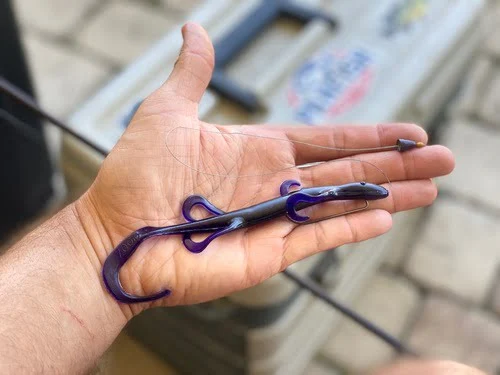
Next, slide a bullet or egg weight to the main fishing line followed by a glass bead. Slide them down the line and connect the line to the other end of the swivel.
Lastly, you will put your lizard onto the hook and you are ready to start fishing!
The Carolina rig is best fished in conjunction with a lizard by dragging it across the area you are trying to target. Cast it out and let it completely sink to the bottom. Placing your pole sideways, slowly pull and retrieve the line with sporadic movements.
Change up the speed and jerks that you throw in the line as you retrieve your lizard.
The Carolina rig excels at working the bottoms with your plastic lizard and will help you cover a lot of water as quickly as possible.
Texas Rig
The Texas rig is the most popular rig to be used with lizards. Not only is this rig great for any skill level, but it can cover a wide range of different conditions and scenarios.
This rig is very simple to make and requires fewer items to create than a Carolina rig.
To make a Texas rig, you will only need your fishing line, a bullet weight (1/4 ounce to 1 ounce), a 3/0 to 5/0 hook, and your plastic lizard.
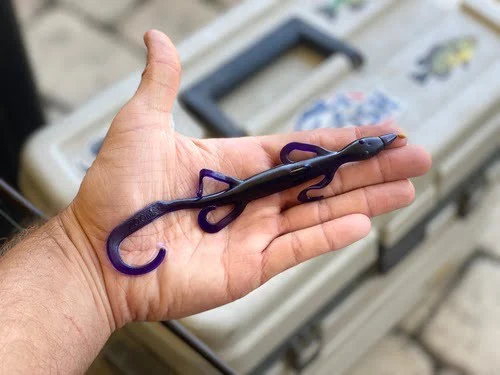
To assemble, simply slide the bullet weight onto your line and then tie on the hook. Add your lizard to the hook and you are ready to fish!
The Texas rig can be pitched, flipped, and dragged around structures, rocks, and heavy vegetation.
It is extremely versatile, but one of the best ways to fish this rig is in weeds and brush by casting it out and allowing it to sink to the bottom.
Next, wait a few moments and be ready for a strike. If nothing happens, sweep your rod to the side in 2 to 3-foot sections of line and then take in the slack.
Slowly do this as you cover the bottoms around vegetation and brush where fish love to hide.
Split Shot Rig
The split shot rig is a great rig to use for a more finesse approach. It is created by placing your plastic lizard on a 3/0 to 5/0 hook and attaching it to the fishing line. Next, place a size 2 or 4 shot weight around 10 to 18 inches above the hook.
With that, you are ready to fish! You can play around with the size of weight and the distance you place it on your line above the hook depending on how the fish are reacting.
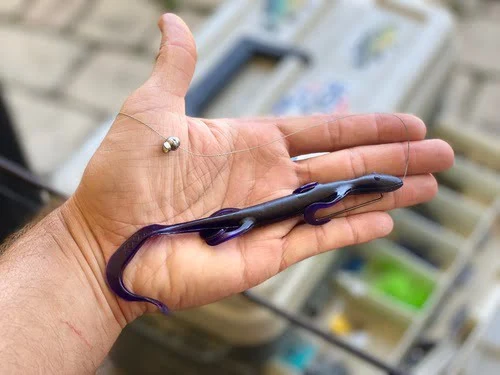
This rig works great in open and clear water when other rigs are not producing a bite.
To best fish with a split shot rig, simply cast it out into your target area and patiently wait for it to sink to the bottom. Fish will most likely hit it on the way down, so be ready to set the hook.
You can give it a few bounces once it hits the bottom, but if nothing hits your lure you can retrieve it and cast it to the next spot.
You May Also Like: Can Largemouth And Smallmouth Bass Breed?
When To Use Lizards for Bass
Plastic lizards can catch bass during any time of the year, but there are times when they tend to work better than other lures.
For example, plastic lizards will usually work the best when used in the spring during the time when the bass are spawning.
During the spring, bass will aggressively protect their nests. Lizards, salamanders, and sirens are notorious for raiding and eating the eggs in these nests, so bass will often strike a lizard during the spring even if they are not hungry.
Lizards, however, will work at any time of the year for bass because they look and act similar to a worm in the water
Think about it…a plastic lizard is just a long, slender, flexible worm with legs! And we all know that plastic lures like the Senko worm are some of the most popular bass baits of all time.
Lizard Fishing Tips
Below are a few of my favorite tips when I’m using plastic lizards for bass fishing.
- During the spring spawning season, if you spot a bass bed…approach very slowly and cast your plastic lizard right on the edge of the bed. Let it sink…and don’t move it! Bass usually can’t stand it and will bite, just be patient!
- Use a yellow bobber stopper on the nose of your plastic lizard. This imitates a bass egg, and can actually resemble a feeding salamander.
- To make your lizard float effortlessly in the water column, cut off a small piece of foam ear plug material, and insert it into the lizard body.
- I always recommend ‘skin hooking‘ your hooks anytime your using a lizard or plastic worm. All you have to do is insert the tip of your hook back into the bait just under the skin. This helps keep it weedless and free from snags!
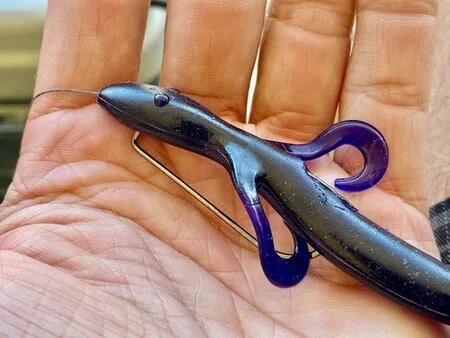
Frequently Asked Questions
How Do You Fish a Weightless Lizard?
Fishing a weightless lizard is done by simply placing your plastic lizard on a hook and nothing else. It is best fished by casting out into shallows, especially where the bass are spawning.
Let it sink and flutter to the bottom. If you do not get a hit, retrieve it and try again somewhere else.
Can You Wacky Rig a Lizard?
The wacky rig usually consists of placing your fishing hook straight through the middle of a stick bait-style worm.
This rig can also be used with a plastic lizard, although it is much less common to see.
While a lizard is best used with other types of rigs, the wacky rig can be a unique way of changing things up to entice a bite. Give it a try!
What Else Can You Catch On Plastic Lizards?
Lizards are primarily a largemouth bass fishing lure. They can, however, catch other fish like crappie, smallmouth bass, bluegill, bowfin, gar and sometimes even catfish.
Plenty of other fish will take any opportunity to feed on lizards or salamanders just like largemouth bass.
What Is the Best Color Lizard for Bass?
The best color lizard for bass depends on the native species in the area that you are fishing. In general, natural colors like watermelon seed, Junebug, black, and green pumpkin are among the top favorites for most bass fishermen.
What is the Best Size Lizard for Bass?
The most commonly used lizard amongst bass fishermen is a 6-inch plastic lizard.
These are a little larger than your average lizard or salamander, but they provide a bigger target and more movement in the water.
Many anglers may also choose to downsize to a 4-inch lizard if the fish are not biting very well on the 6-inch variety.
I personally like to use 6″ size lizards, in a two-toned pattern like this cotton candy and chartreuse pattern.

You May Also Like: Using Bluegill For Bass Bait? Don’t Miss These Tips!
If you haven’t guessed yet, I love fishing and everything about it!
To learn more about why I started Panfish Nation, visit the About page and follow along on Social Media:


Download a copy of my FREE Lure Color Selection Chart & Knot Guide!
Stay up to date with fishing reports, tackle reviews, industry news, and much more! We respect your privacy, unsubscribe at any time.
Related Posts
- What Size Hooks for Smallmouth Bass? Quick Guide
- Large and in Charge-Mouth: 10 of the Best Bass Lures of All Time (And Where to Buy Them)
- The Seven Best Lures for Fall Bass Fishing
- Which Fishing Line is Best for Bass Fishing With A Spinning Reel?
- What Size Hooks for Panfish?
- What Is The Best Fishing Line For Bluegill?



